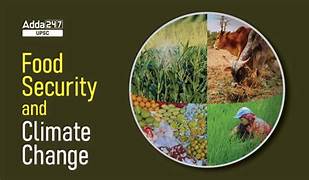Climate Change and Food Systems: A Multidimensional Sustainability Approach
Climate change is no longer a distant threat but a pressing reality that is altering ecosystems, economies, and societies across the globe. One of the most critical and interconnected sectors affected by climate change is food systems. Agriculture, food production, and distribution are directly impacted by changing climate patterns, and in turn, these systems contribute significantly to climate change through greenhouse gas emissions. In this context, the need for a comprehensive, multidimensional sustainability approach to food systems has never been more urgent.
This article examines the impact of climate change on food systems and proposes a multidimensional sustainability framework to address the interconnected challenges posed by both climate change and food insecurity. It highlights how agricultural practices, food distribution networks, and consumption patterns must adapt to ensure the resilience of food systems, while also reducing their environmental footprint.
The Relationship Between Climate Change and Food Systems
Food systems are complex, comprising all the processes involved in the production, processing, distribution, and consumption of food. These systems are directly influenced by climate change, which affects weather patterns, water availability, soil health, and the occurrence of pests and diseases. However, food systems are also key contributors to climate change. According to the Food and Agriculture Organization (FAO), agriculture and food systems account for roughly 25-30% of global greenhouse gas emissions, making them a significant driver of global warming.
Climate change disrupts food systems in multiple ways. Rising temperatures, shifting rainfall patterns, and more frequent extreme weather events like droughts, floods, and heatwaves are already affecting crop yields, livestock productivity, and food availability. For instance, staple crops such as wheat, maize, and rice are sensitive to changes in temperature and water availability. As the climate becomes less predictable, farmers are faced with greater uncertainty, leading to reduced productivity and increased vulnerability to food shortages. Additionally, the impacts of climate change exacerbate existing inequalities in food access, especially in regions that are already vulnerable due to poverty, conflict, and inadequate infrastructure.
On the other hand, food systems contribute to climate change through land-use practices, deforestation, food waste, and the energy-intensive nature of modern agriculture. The clearing of forests for agricultural land, for instance, releases large amounts of carbon dioxide into the atmosphere, while unsustainable farming practices, such as overuse of chemical fertilizers and pesticides, increase emissions of nitrous oxide—a potent greenhouse gas.
Therefore, addressing the challenges posed by climate change requires a holistic approach that integrates environmental, economic, and social dimensions of sustainability. This approach must not only focus on mitigating the impact of food systems on the climate but also ensure that food systems themselves are resilient to the effects of climate change.
The Pillars of a Multidimensional Sustainability Approach
To develop a sustainable food system that can withstand the challenges of climate change, it is essential to consider three core pillars: environmental sustainability, economic sustainability, and social sustainability. These pillars are interlinked and must be pursued simultaneously to create a food system that is both resilient and capable of reducing its environmental footprint.
1. Environmental Sustainability: Climate-Resilient Agriculture
Environmental sustainability in food systems focuses on reducing the environmental impacts of agriculture while ensuring that food production can continue in a changing climate. Sustainable farming practices, such as agroecology, conservation tillage, crop rotation, and organic farming, are essential in building resilience to climate change. These practices help maintain soil health, conserve water, and reduce the reliance on chemical fertilizers and pesticides.
A key element of environmental sustainability is increasing the climate resilience of agricultural systems. Climate-resilient agriculture involves adopting farming practices that can withstand extreme weather events, such as droughts, floods, and heatwaves. This includes selecting drought-tolerant crop varieties, improving soil water retention, and implementing water-efficient irrigation techniques. For instance, drip irrigation systems are becoming increasingly popular in water-scarce regions, as they allow for more precise water delivery and reduce waste.
Another important component of environmental sustainability is the reduction of greenhouse gas emissions from agriculture. Sustainable food systems must minimize the environmental impact of farming by improving energy efficiency and adopting low-carbon technologies. For example, integrating renewable energy sources such as solar and wind power into agricultural operations can help reduce the carbon footprint of food production. Additionally, agroforestry—combining trees with crops or livestock—can help sequester carbon, reduce soil erosion, and enhance biodiversity.
2. Economic Sustainability: Supporting Sustainable Livelihoods
Economic sustainability focuses on ensuring that food systems are economically viable, providing stable incomes for farmers, workers, and communities while maintaining the ability to meet growing food demand. Climate change poses a significant economic challenge to agriculture, particularly for smallholder farmers who may lack the resources to adapt to shifting climate patterns. Increasing economic resilience within food systems requires investing in sustainable agricultural practices that can withstand climate variability while promoting long-term economic stability.
Diversification of agricultural production is one strategy that can enhance economic sustainability. By encouraging farmers to grow a variety of crops or raise different types of livestock, the risk of crop failure or market volatility due to climate-related events can be minimized. For example, intercropping—growing different types of crops together—can help reduce the risk of crop losses and improve soil fertility.
Access to financial resources and technology is another critical component of economic sustainability. Farmers need access to credit, insurance, and training to adopt climate-smart agricultural practices. For instance, microfinance programs can help small-scale farmers invest in climate-resilient technologies, while crop insurance schemes can provide a safety net in the event of crop failure due to extreme weather.
In addition, promoting sustainable value chains that support local food systems can strengthen economic resilience. This includes reducing reliance on global food trade and supporting local food markets, which can provide more sustainable livelihoods for farmers and help communities better adapt to climate disruptions.
3. Social Sustainability: Ensuring Food Security and Equity
Social sustainability is essential for creating food systems that are equitable and capable of ensuring access to healthy, nutritious food for all people, especially in the face of climate change. Food insecurity is already a widespread issue, and climate change is likely to worsen the situation, particularly for vulnerable populations in developing countries. Ensuring social sustainability involves addressing issues such as poverty, inequality, and access to food, while also promoting the rights and well-being of all individuals involved in food production.
One of the main objectives of social sustainability in food systems is to ensure food security. Climate change poses a direct threat to food security by reducing the availability and accessibility of food, especially in regions that rely on rain-fed agriculture. To mitigate this, it is important to invest in social safety nets, including social protection programs that provide food assistance during times of crisis and support for vulnerable populations.
In addition to food security, social sustainability must address gender equality and the empowerment of women in agriculture. Women play a critical role in food production, particularly in developing countries, yet they often face greater challenges due to limited access to resources, education, and decision-making power. Promoting gender equality in food systems can enhance productivity, improve resilience to climate change, and promote equitable access to food.
Education and awareness-raising about sustainable agricultural practices are also crucial for social sustainability. By providing farmers and communities with the knowledge and tools to adapt to climate change, they can better navigate the challenges posed by shifting weather patterns, soil degradation, and water scarcity.
Integrating Sustainability into Food Systems
To create a sustainable and resilient food system in the face of climate change, an integrated approach that combines the environmental, economic, and social dimensions is essential. Policy frameworks that promote sustainable agriculture and food systems must be developed at the local, national, and global levels. Governments, international organizations, the private sector, and civil society must work together to implement policies that support climate-resilient agriculture, reduce food waste, and ensure equitable access to food.
Climate-smart agriculture (CSA) is an example of such an integrated approach. CSA promotes practices that increase agricultural productivity, adapt to climate change, and reduce greenhouse gas emissions. This approach includes a range of strategies, such as improving soil health, optimizing water use, and diversifying crops. By combining these strategies, CSA can help build food systems that are more sustainable, resilient, and able to meet the needs of a growing population.
Conclusion: Moving Towards a Sustainable Future
The challenge of climate change is immense, but the potential for creating a more sustainable food system is within reach. A multidimensional sustainability approach that integrates environmental, economic, and social sustainability is key to addressing the complex challenges faced by food systems. By promoting climate-resilient agriculture, supporting sustainable livelihoods, and ensuring food security for all, we can build food systems that are both sustainable and adaptable to the changing climate. This requires bold action, collaboration, and a commitment to making food systems more resilient, equitable, and environmentally responsible. Only by working together can we ensure that future generations have access to the food they need while protecting the planet’s health for years to come.


